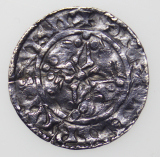Viking
The Viking Invasion of Britain
Danelaw, Viking East Anglia, St. Edmund Memorial Silver Penny, Rodulf Moneyer, c885-915, RARE
Obverse:Capital A in inner circle, + S (reversed) C (reversed) C E.AD IVI = +SC EADMVND RE - S[an]C[te] Eadmunde King (later types are somewhat blundered)
Reverse: Small cross patee in inner circle, +RODULII (possibly Rodulf moneyer)
Size: 18mm, 1.36g
Grade: NGC AU Cert no: 6945305-039 enviromental damage
Ref: cf Blackburn's Viking Coinage in British Isles, p277, North 483, S960
£1,200 (P&P FREE to all locations)
Vikings at York, Cnut Patriarchal Cross Penny, c895-902
Reverse: CVN.NET.TI around small cross with pellets
19.2mm, 1.3g
Ref: S990
Grade: EF, excellent example, well centred, toned with some original lustre
Prov: Ex Eldreds
£1,550 (P&P FREE to all locations) #1252
STAR PIECE - Anlaf Guthfrithsson Raven Type Penny Fragment, 939-954
Reverse: A small central cross with legend around naming moneyer
Grade: Central section only, broken into two, repaired
13mm at widest, 0.47g (whole coin would be about 1.15g)
Ref: S1019
Will be supplied in film display box for protection.
£2,500 (P&P FREE to all locations)
Viking York, St. Peter Coinage, York, Swordless Penny, Large Fragment,
AD 905-910 RARE
Harold Bluetooth (Harald Blatand) Silver Half-bracteate,c958-985 RARE
Geometric design based around a cross with trefoil terminals overlying an abstraction of a facing figure in a boat.
The thiness of the silver allowed ghosting of the obverse design. Bluetooth's conversion to Christianity is clearly shown in his coinage with the cross very evident. Hedeby or Jelling are possible mints.
Grade: EF, good round flan, strong strike, no splits or scuffs, extremely rare
16mm, 0.3g
Ref: Cf C Moesgaard, King Harold's Cross Coinage p266 fig. A4.9
History note: And yes, renowned for his good communication skills, the Bluetooth name was used by the mobile phone company Ericsson!
PRICE on application (Delivery FREE to all locations)
Hiberno-Scandinavian, Long Cross Hand Type, Phase III Silver Penny, Dublin Mint, Certified, 1035-1060
Grade: VF+ slightly buckled, PCGS certified AU 53 (slabbed)
Ref: S6132A, SCIBI BM125
17mm, 0.98g (15.1 grains)
Prov: Ex Noonan's, M J McKeever Collection of Irish Coins
£800 (P&P FREE to all locations)
Hiberno-Scandinavian, Sihtric Anlafsson (Silkbeard), Phase III Silver Penny 1035-1060
Reverse: Long voided cross with hands in two quarters, blundered legends around
Grade: VF+ slightly crimped, excellent portrait, toned
Ref: S6132, SCIBI BM104
17.5mm, 1.12g
Prov: Ex DNW 2017
£2,000 (P&P FREE to all locations) REDUCED £1,500
Danish issue, Hardeknud (Harthacnut), Silver Penny, Triquetra (Triskele) Type, Roskilde Mint, Denmark, 1035-42, RARE
Obverse: Intervoven triquetra shape with pellet ornamentation, legend clear but somewhat blundered reading (Anglicised) IγnOrγcIIIOAD
For further discussion about this coin visit the Blog page.
Reverse: Small central cross, legend γr’CCOShγIICCO
Ref: Hauberg 33, S1170
0.88g, 19mm
Grade: AVF with a few small cracks, peck marks, RARE
Prov: Ex Noonan's
£1,100 (P&P FREE to all locations)
Danelaw, Viking East Anglia, St. Edmund Memorial Coinage, Silver Penny, Adradus Moneyer, c885-915, RARE
Svend Estridsen, 1047-75, Silver Penny, Lund Mint, Svartbrand Moneyer
Obverse: Christ, nimbate, standing facing, raising hand in benediction and holding Gospels; straight lines in nimbate; annulated pellet in right field, +MAGNAS REX
Note: This coin has obvious Byzantine influences. A vast amount of treasure was known to have come from this region and the early development of their coinage reflects this along with that of the British coinage.
Danelaw, Viking York, St. Peter Coinage, Two Line Penny, AD 905-910 RARE
Raids on British soil began in the late 8th century, the first monastery to be invaded was in 793 on Lindisfarne. The men from the North were primarily interested in gold and other precious objects; there was no point attacking ordinary folk, they had little to offer, for the moment. This changed later, as slaves and land became their intent. Skirmishes continued until 1013, then Sweyn Forkbeard returned to invade England in earnest, with a large army. Aethelred, the king at the time, fearing for his life, he fled to France and Forkbeard took the throne of England. The last raid took place in 1066.
Viking, was never a term the Norsemen called themselves, it was Old Norse meaning 'adventure and trade.' It was first used in the English vocabulary in the 18th century and just meant 'a Scandinavian'.



